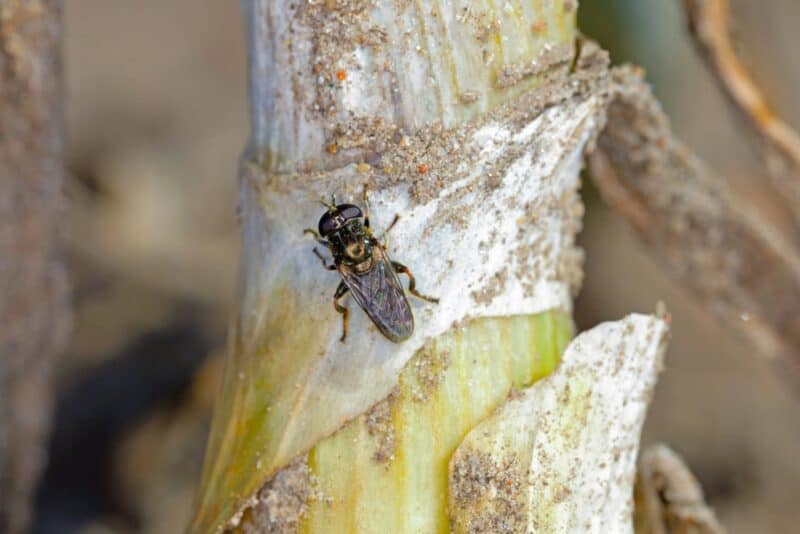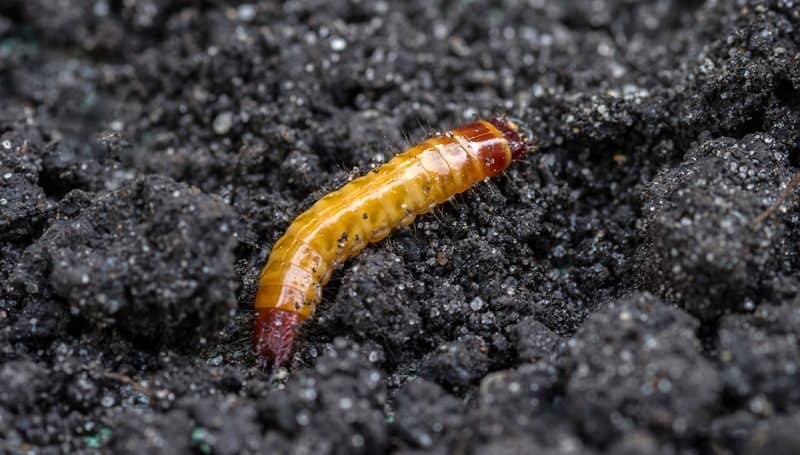The allium family of plants has some of the most common and best-loved food crops in the world, with a variety of flavorful and healthy options like onions, chives, garlic, leeks, and scallions. But alliums can suffer from pests and diseases, just like anything else.
Alliums are usually easy to grow, simple to harvest, and trouble-free to store long term. But they can still have their problems. They’re not immune to issues like dampening off, cutworms, aphids, downy mildew, and thrips.
Whether you’re growing scallions, spring onions, hard-necked garlic, leeks, or soft-necked garlic, alliums all have similar needs. Plant them in well-drained, fertile soil with plenty of sunlight. Both onions and garlic prefer soil with an ideal pH – 6.5 or 7.0 is perfect.
Like any plant with generations of cultivation behind it, alliums have a number of pests to contend with, and they can share pests easily, though some that harass onions will leave garlic alone.
If you’ve had trouble with pests, crop rotation is a good preventative practice. Move your alliums each season to confuse the pests that have overwintered in last season’s onion bed.
Garlic has very few pests (though it shares many of the diseases common to onions). Onions have a few very damaging pests as well. Chives, scallions, ornamental alliums, leeks, and shallots, on the other hand, tend to have more.
This pest is new to North American allium growers. It became a noticeable problem only recently, in 2016. But allium leafminer (Phytomyza gymnostoma) is already a devastating pest.
These tiny insects can devastate your garlic, onion, leek, and other allium crops. Tiny, cream-colored grubs leave a trail of wavy, shrunken, and damaged leaves behind them as they feed.
Allium leafminers spend their larval stage on the allium plant, then drop off to pupate in the soil. The adults emerge as flies and quickly lay eggs on nearby allium plants.
Controlling these pests is simply a matter of crop rotation and row covers. Move your alliums each spring and cover the young plants with row covers to prevent adult allium leafminers from laying eggs on your alliums.
Onion flies (Delia antiqua) are a common pest of alliums. It’s the larvae that do all the damage. These hideous, quarter-inch long white maggots feed on roots. They can easily kill seedlings and older plants.
But they often burrow into bulbs, feeding slowly. Affected bulbs are absolutely inedible. Destroy any infected plants. Don’t compost them – onion maggots can thrive in compost piles.
Crop rotation and beneficial nematodes are great ways to prevent infection. Try applying nematodes to the soil before planting your onions. Then, cover young plants with row covers to keep the adult onion maggot fly from laying eggs on your plants.
Allium plants like garlic onions leeks, and chives are susceptible to various diseases that can affect their health and growth. Properly identifying and treating these diseases is crucial for a successful harvest. This article provides an overview of common allium diseases, how to identify them, and effective treatment methods.
Common Allium Diseases
Some of the most prevalent diseases affecting allium crops include:
-
Onion White Rot – Caused by the fungus Sclerotium cepivorum. It affects the roots and bulbs, turning them into a soft, mushy texture. The leaves become yellow and wilt. Small black sclerotia bodies may be visible on infected plants.
-
Downy Mildew – Caused by the oomycete Peronospora destructor. It first appears as yellow spots on leaves which turn brown or purple. A downy gray growth covers the lesions in wet weather. Entire plants can be stunted and bulbs can become shriveled.
-
Purple Blotch – Caused by the fungus Alternaria porri. Small lesions appear on leaves as brown spots with purple centers. The spots enlarge and combine to cover most of the leaf surface.
-
Stemphylium Leaf Blight – Caused by the fungus Stemphylium vesicarium. Starts as small brown spots that expand and become tan, often with purple borders. Heavily infected leaves shrivel and die.
-
Botrytis Leaf Blight – Caused by the fungus Botrytis squamosa. Small necrotic spots appear on leaves, often surrounded by a silvery halo. Spots grow larger and combine to kill the entire leaf.
Identification
Carefully examining plants and paying attention to lesion shape. color. and growth patterns is key to identifying the disease
-
Onion white rot – Mushy roots and bulbs, wilted yellow foliage, sclerotia on infected tissue
-
Downy mildew – Yellow leaf spots, downy gray sporulation, stunted plants, shriveled bulbs
-
Purple blotch – Small brown lesions with purple centers that expand
-
Stemphylium leaf blight – Tan leaf spots with purple borders that expand
-
Botrytis leaf blight – Silvery halos around necrotic spots that expand
A microscope can help confirm identification by examining the spores and reproductive structures of the pathogens. Submitting samples to diagnostic labs can also provide definitive diagnosis.
Treatment Methods
An integrated approach utilizing cultural practices, sanitation, and organic sprays when necessary can effectively manage allium diseases:
-
Employ long crop rotations of 3-4 years to prevent disease buildup in the soil
-
Remove and destroy crop debris after harvest to eliminate inoculum sources
-
Avoid excessive nitrogen fertilization which encourages foliar diseases
-
Allow proper air circulation to promote quick drying after rain or irrigation
-
Disinfect tools and equipment regularly to prevent spreading diseases
-
Apply compost tea sprays to suppress foliar pathogens and induce systemic resistance
-
Use organic fungicides containing Bacillus subtilis as a preventative spray program
-
Rogue and destroy severely infected plants to prevent further spread
Quickly diagnosing and treating allium diseases is crucial for maintaining healthy crops. Know the identifying characteristics of common pathogenic diseases, and be prepared to take action with proper cultural practices and organic pesticides when needed. Paying close attention and utilizing integrated disease management gives alliums their best chance of reaching full, productive maturity.

Fusarium Bulb Rot
Bulb rot is a fungal disease (Fusarium oxysporum) that affects the bulb and stem of alliums. Unfortunately, no cultivars are fully resistant to Fusarium bulb rot, though you can reduce the chance of this disease by planting semi-resistant onion varieties like ‘Early Yellow Globe’ or ‘Pulsar.’
Alliums affected by Fusarium bulb rot have soft, weak necks. The bulbs become soft, brown, and rotted. Eventually, the entire plant rots away. Destroy affected plants immediately and treat the rest of your alliums with a copper-based fungicide to reduce spread.
Lesser Bulb Flies

Lesser bulb flies (Eumerus funeralis) are only “lesser” in relation to onion maggots. They cause similar damage to onions (and occasionally garlic), but rarely on as large a scale. Lesser bulb fly larvae are about twice the size of onion maggots and yellowish-grey in color.
Treat them as you would onion maggots, with beneficial nematodes and row covers. Destroy affected plants.
With both onion maggots and lesser flies, it’s important to clear every onion out of the garden at the end of the season. Without onions to feed on, these flies will die. So avoid leaving an allium or two to rot in the field – it’s an invitation to onion maggots and lesser bulb flies.

Wireworms are slender, tough-bodied little worms that are the larvae of click beetles in the Elateridae family. They rarely grow above one-and-a-half inches long and they feed on roots and bulbs. You’ll notice the tops of your onions growing yellowish and wilted as the roots are slowly destroyed.
Fortunately, wireworms can be managed with nematodes as well. The treatment for onion maggots and bulb flies works just as well on wireworms.
Alliums can fall prey to a wide variety of diseases. Despite the fact that alliums themselves are anti-viral, anti-biotic, and anti-fungal in their effect on humans and animals, they’re not immune to a variety of garden viruses, bacteria, and fungi.
Don’t make the mistake of trusting your alliums to stand strong against all the pathogens that have developed specifically to attack them. Fungi are the most common cause of allium issues.
While many allium diseases refer specifically to onions, these pathogens can just as easily attack garlic, leeks, and other allium cultivars as well.
If the bulbs and roots of the plant are pinkish, while the tops are stunted and yellowish, the plant has pink root. This fungal disease (Phoma terrestris) causes the roots of the allium to shrivel and die. Once the disease has set in, there’s no cure. Destroy affected plants completely.
To prevent pink root, make sure to space your alliums well. Plant them in well-drained soil. You can apply a copper-based fungicide as a preventative measure if you’re concerned about pink root.
It may reduce the spread of pink root or prevent a resurgence of the disease. But, if you’ve had problems with pink root before, the best option is to plant resistant cultivars such as ‘Early White Supreme,’ ‘Tokyo Long White,’ or ‘Super Star.’
Identifying and Treating Common Plant Diseases
FAQ
What are the symptoms of allium disease?
What illness does allium have?
How to get rid of allium leaf miners?
What are the pests of the ornamental allium?
